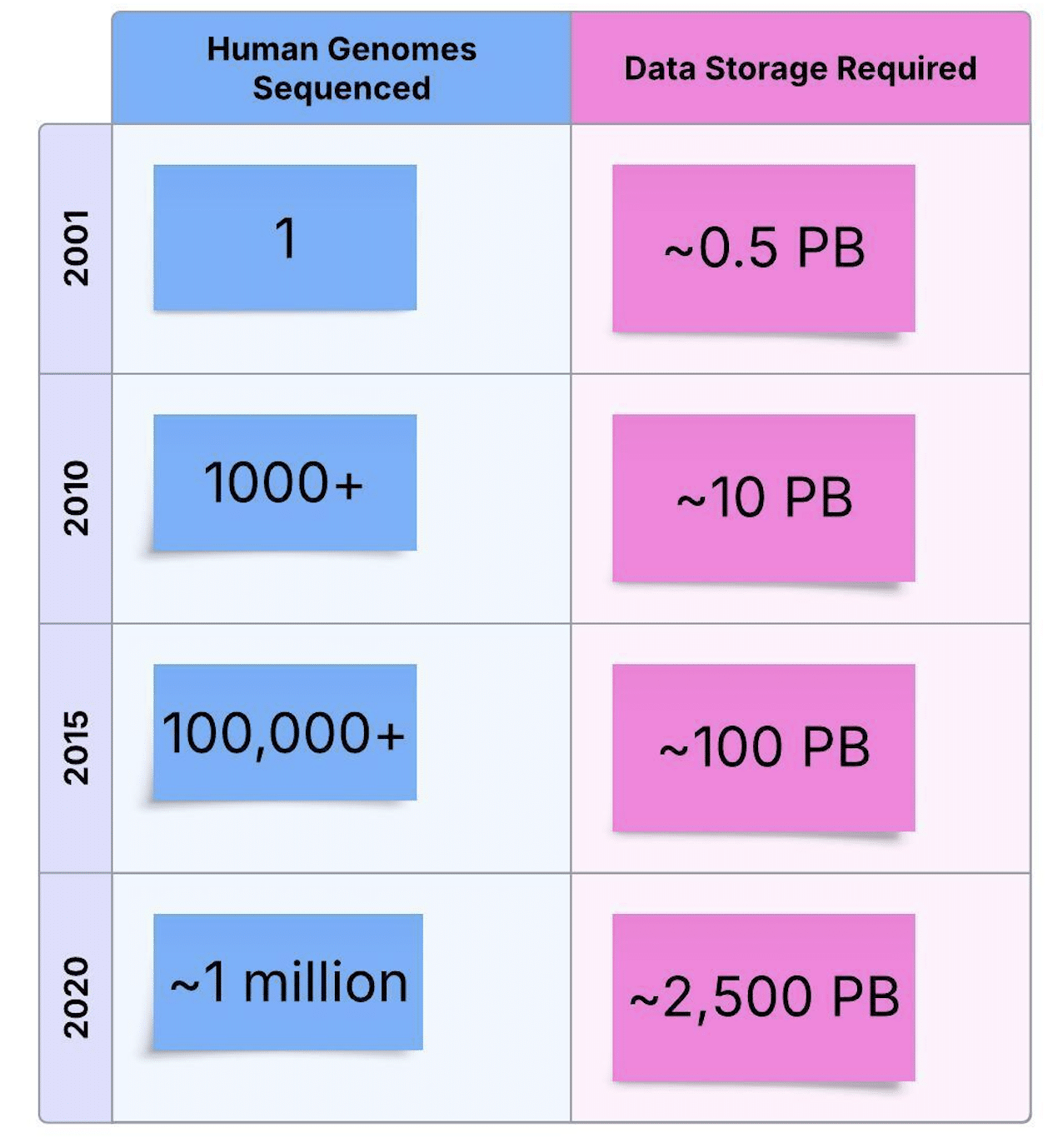Biological research is generating more data than ever before, from sequencing genomes to analyzing complex biological systems such as plants, microalgae, human cells, microbes, fungi, etc.
However, storing and processing these massive datasets has become a growing challenge. Processing all this data the traditional way—on local desktop machines or even institutional servers often leads to bottlenecks and slows down discoveries. [1]
But what if you could rent a supercomputer anytime you needed it? That’s where cloud computing comes in.
In this article, we’ll break down what cloud computing is, why it’s becoming essential in genomics, and how biologists can use it to speed up research, collaborate globally, and scale their data processing without investing in expensive infrastructure
The Data Problem in Modern Biology
In recent years, biological research has shifted from generating a few megabytes of data in laboratory experiments to handling terabytes—or even petabytes—of information.
For example, the Human Genome Project took 13 years to complete, [2] but today, whole-genome sequencing can be done in hours thanks to cloud computing. [3]
Another major initiative, the Human Cell Atlas [4] aims to categorize the 37 trillion cells in the human body, producing vast amounts of data that require advanced computational solutions.
Traditional computing methods, which rely on local servers and personal computers, struggle with such immense datasets.
Managing and storing them becomes not only inefficient but also prohibitively expensive due to the high costs of hardware, maintenance, and physical space. Upgrading physical infrastructure to accommodate this data growth would require massive investments, making cloud computing a more practical alternative.
What is Cloud Computing?
Cloud computing provides storage and processing power on demand, allowing researchers to access powerful computing resources without owning expensive hardware. Whether dealing with datasets of five trillion or ten trillion cells, researchers can scale their computing power as needed.
Instead of relying on a single computer or a local server, cloud computing allows researchers to access scalable, high-performance computing resources over the internet—essentially renting a supercomputer when needed.
Think of it like a plant cell. Chloroplasts absorb sunlight and convert it into energy, much like a cloud server processes data and makes it accessible. Just as mitochondria distribute energy throughout the cell, cloud computing networks distribute processing tasks across multiple servers, ensuring efficient data processing.
How Cloud Computing Works
In traditional computing, everything runs on a local server or workstation, like conducting an experiment on a single benchtop. But, as experiments scale, more equipment, lab space, and personnel are needed.
Cloud computing operates similarly, expanding computational capacity without requiring researchers to manage the infrastructure.
Imagine running single-cell RNA sequencing on 50,000–100,000 samples. Using traditional setups, you would need to purchase and configure a dedicated server, which could take weeks or even months to be fully operational.
In contrast, cloud computing allows you to rent the necessary computing power instantly—whether for a few hours or months—without concerns about maintenance, hardware upgrades, or storage limits.
Leading cloud platforms such as Google Cloud Life Sciences, Amazon Web Services (AWS), [5] and Terra provide automated resource allocation based on workload. This eliminates bottlenecks in research projects.
Back in 2016, during my own research in river ecology, we conducted metabarcoding sequencing analysis on 150+ samples. Senior researchers often struggled with computing power limitations or the fear of data loss. If we had access to cloud computing, these concerns would have been minimized by providing seamless data storage, scalability, and collaboration.
Let’s look at some of the advantages and drawbacks of cloud computing in science.
Advantages of Cloud Computing for Scientists
- Scalability: Easily scale computing resources based on the size of your or project needs.
- Cost-Effective: Pay-as-you-go model eliminates the need for costly infrastructure upgrades and maintenance.
- Faster Processing: High-performance computing enables rapid analysis of large datasets.
- Global Collaboration: Share data and workflows in real time with teams across institutions and countries.
- No Infrastructure Maintenance: Cloud providers handle server maintenance and safety.
Drawbacks of Cloud Computing
- Data Security Concerns: Sensitive data, like patient genomes, may be at risk if not properly encrypted or managed.
- Recurring Costs: Over time, subscription or usage-based fees may accumulate, especially with large datasets.
- Internet Dependence: Requires a stable and fast internet connection for uploading, processing, and downloading data.
- Learning Curve: Some platforms require technical expertise or training to use effectively, which is initially challenging for a biologist.
- Vendor Lock-In: Moving data between different cloud providers (e.g., AWS to Google Cloud) can be complicated.
Bridging the Gap: Why Biologists Need the Cloud
The Explosion of Biological Data
With the rise of next-generation sequencing (NGS), digital microscopy, and multi-omics approaches, biological research is data-heavy like never before. A vast array of datasets stands to benefit from cloud computing, but among them, omics data, particularly genomic data, serves as a prime example.
Thanks to optimized protocols for extracting nucleic acids and sequencing genomes across a wide range of organisms, we now generate immense volumes of high-quality data. Let’s take genomic data as a case study:
- A single human genome sequence is ~150 GB.
- Large genome-wide association studies (GWAS) involve thousands of genomes, requiring petabytes of storage.
- Single-cell RNA sequencing (scRNA-seq) generates millions of data points per experiment.
Managing this amount of data on a personal computer or a local lab server is impractical. Traditional storage solutions not only run out of space but also struggle to process data fast enough, leading to days or even weeks of computational delays.
Figure 2 highlights the data challenge in modern biology. As genome sequencing becomes more accessible, the amount of data generated grows exponentially, far outpacing available storage solutions.
This reinforces the critical need for scalable cloud infrastructure to manage, store, and analyze such volumes efficiently.

How Cloud Computing Powers Modern Genomics Research
By leveraging cloud computing, you can:
- Store unlimited data without worrying about hardware limitations.
- Access high-performance computing on demand, eliminating the need to maintain expensive local servers.
- Collaborate in real time with global research teams, enabling seamless data sharing and joint analysis.
For example, during the COVID-19 pandemic, scientists worldwide used cloud-based genomic platforms to track emerging variants in real time. [6] Cloud infrastructure enabled instant sharing of sequencing data across borders—something that wouldn’t have been possible with traditional systems.
The Human Genome Project took 13 years to complete. Today, thanks to cloud-based AI and parallel processing, whole-genome sequencing can be done in hours.
Platforms like DNAnexus and Seven Bridges allow researchers to analyze genomes at scale without the need for on-premises bioinformatics expertise.

How You Can Bring the Benefits of Cloud Computing to Your Lab
Upload Large Amounts of Data
Platforms like Terra, AWS HealthOmics, and Google Cloud Life Sciences allow you to securely upload and store sequencing data.
Use Pre-Built Pipelines and Avoid Coding
Instead of writing custom scripts, researchers can run workflows for RNA-seq, variant calling, and multi-omics integration with just a few clicks.
Save time and Automate Repetitive Tasks
Cloud computing reduces manual work, allowing wet-lab researchers to focus more on experimental design and interpretation.
See Table 1 below for a summary of recommended cloud platforms matched to common research areas.
Table 1. Recommended cloud platforms by research areas.
|
Terra, AWS, HealthOmics, DNAnexus |
Optimized for sequence pipelines, population-scale data |
|
|
Seven Bridges, Google Cloud Life Sciences |
Strong integration of data types and collaboration tools |
|
|
OMERO (hosted), Google Cloud + TensorFlow |
Built for imaging data and machine learning |
|
|
Galaxy, OpenMS (cloud-deployable) |
Community-supported, customizable workflows |
|
|
Terra, AWS HealthOmics, MG-RAST (cloud-based) |
Designed for microbiome, environmental sequencing workflows |
|
|
HIPAA/GDPR-compliant, supports FDA and CLIA regulations |
The Future of Cloud-powered Biology
Looking ahead, cloud computing will continue to revolutionize biological research.
One of the key trends is the increasing use of AI-driven cloud tools that will automate and accelerate complex analysis of gene modeling, microscopic image analysis, protein structure prediction, genomic sequencing, and drug discovery simulations, allowing researchers to focus more on interpreting results rather than performing manual tasks.
For example, tools like AlphaFold have significantly advanced protein structure prediction, to model protein configurations with precise accuracy. [7]
Cloud computing will also play a central role in personalized medicine, where genomic data is used to tailor treatments to individual patients.
With the ability to process vast amounts of patient data in the cloud, medical professionals will be able to make more accurate diagnoses and treatment recommendations based on their genetic profiles, improving outcomes for patients with genetic disorders or cancer.
The integration of big data analytics further enhances the ability to identify patterns and correlations within diverse patient datasets, facilitating the development of customized treatment plans. [8,9]
Moreover, the trend toward decentralized cloud computing will enhance data security and ensure that sensitive genetic data is shared and processed in a secure and compliant manner, without relying on centralized servers.
Conclusion: The Power of Cloud Computing for Biology Summarized
Cloud computing is changing the landscape of biological research, making it easier, faster, and more cost-effective to analyze complex data sets, whether that be processing genomic sequences, proteomics, or microscopy imaging.
Integrating AI algorithms and cloud computing offers a powerful speed, scale, and analytical power to reshape how modern biology is done.
It provides us with an open and flexible platform to store and manage massive datasets with ease, and troubleshoot pipeline errors by automating workflows from whole-genome variant calling to proteomics quantification.
Not only the gene sequences, but it can also analyse the thousands of microscopy images needed to predict protein structures at a pace that simply isn’t feasible on local machines.
By offloading these demands to the cloud system, we can focus on what matters: asking better questions, designing smarter experiments, and making faster discoveries.
References
- Dahlquist JM, Nelson SC, Fullerton SM. (2023). Cloud-based biomedical data storage and analysis for genomic research: Landscape analysis of data governance in emerging NIH-supported platforms. Human Genetics and Genomics Advances. 4(3):100196
- Human Genome Project. Human Genome Project History. URL: (Accessed April 15, 2025)
- The Future of Genome Sequencing is Object Storage. URL: (Accessed April 15, 2025)
- Rozenblatt-Rosen O, Stubbington M, Regev A. et al. (2017). The Human Cell Atlas: from vision to reality. Nature. 550:451–453
- Amazon Web Services. (Accessed April 15, 2025)
- Digital Technology Supercluster. Covid Cloud. URL: (Accessed April 15, 2025)
- Cizauskas C, DeBenedictis D, Kelly P. (2025). How the past is shaping the future of life science: The influence of automation and AI on biology. New Biotechnology 88:1–11
- Adivi. Cloud Computing in the Healthcare Industry. URL: (Accessed April 15, 2025)
- Asahi Technologies. Leveraging Big Data Analytics for Precision Medicine. URL: (Accessed April 15, 2025)



1 Comment
aa1q7k